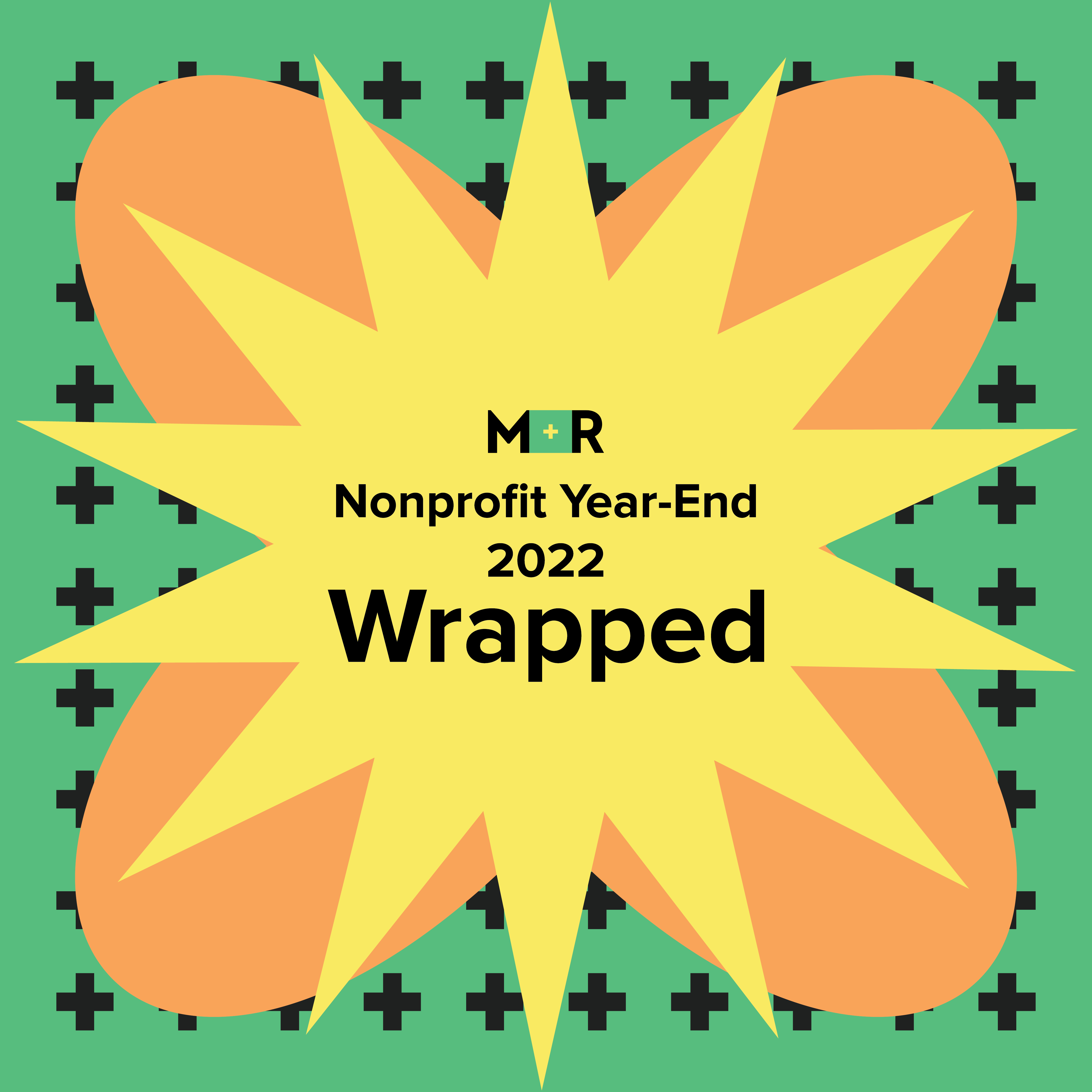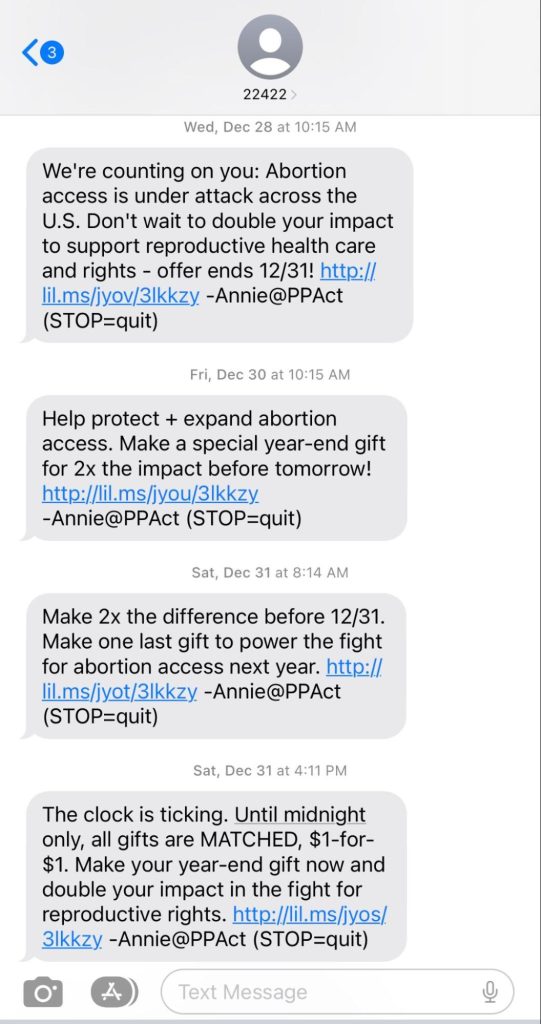In December, Spotify’s 2022 Wrapped revealed that I listened to Taylor Swift’s Bejeweled 42 times in one day (I regret nothing!). In that spirit, we’re taking a look back at December fundraising — our Nonprofit Year-End 2022 Wrapped.
We surveyed our nonprofit clients to dig into the trending hits and surprise breakout stars when it came to 2022’s year-end fundraising playlist, with detailed results from 21 organizations. This data includes a mix of organizations that work on topics ranging from international relief to health to environmental issues.
For our overall analysis, we included only one-time gifts — ongoing monthly revenue is not included in those numbers, and all gifts are in the months of November and December in order to include Giving Tuesday. The averages we report for each metric are medians — they represent the middle nonprofit out of all those that provided data. This helps us avoid having averages skewed by a single participant, something I wish Spotify had done with my musical listening habits…
Year-End Hits
This was a tough-ish year for nonprofits hoping to see substantial year-end growth over 2021.
71% of the nonprofits surveyed saw a small decline in year-over-year revenue, and 60% saw a decline in the number of gifts. Average gift size followed the same trend, with 60% seeing declines.
The causes seemed mixed: Some groups saw a return to a baseline after a few years of outstanding revenue growth influenced by the pandemic. A few outlier nonprofits saw huge influxes of new supporters and revenue due to the conflict in Ukraine or the Supreme Court majority’s radical, outrageous, despicable decision eliminating federal constitutional protections for legal abortion. Nonprofits that work on issues outside of those realms found it harder to garner new supporter attention and support. Some nonprofits that typically rely on political messaging struggled at year-end after the mixed results of the 2022 elections. And inflation coupled with the looming warnings of a recession certainly didn’t help.
The playlist also looked different for different types of nonprofits — every single environmental group that reported data in our sample experienced a decrease in year-over-year overall revenue. And sectors that were more likely to see outpourings of pandemic-related support like cultural institutions and hunger & poverty groups were also more likely to see year-over-year declines.
Digital Revenue Unplugged
The median nonprofit saw their overall online giving decline by 4.0%. Those aren’t the results we all want to see, but given all the factors at play, there’s more to dig into beyond that topline number.
First off, the change in the number of gifts, year over year. From 2021 to 2022, among the group of nonprofits we studied, the number of gifts declined by nearly 3.7%. This continues a trend we’ve seen for a few years now — annual year-end giving behavior has shifted somewhat toward being more event- or crisis-driven, which sometimes causes huge spikes in donations at other times of year, but fewer during the “typical” year-end period. And nonprofits need to work harder to retain those crisis givers for a second gift.
And it wasn’t just the number of gifts — the size of gifts declined too. The median nonprofit saw their average gift decrease nearly 4.4%. This upsets a trend we’ve seen the past few years, in which average gifts have continued to rise and rise — and may be a sign that nonprofits can no longer continue to rely on rising gift sizes to offset declines in overall gift count.
As we looked to specific channels, we did see a bit more divergence, with potentially more influence from messaging, audiences, timing, offers, and other strategic and tactical choices. Let’s dig in!
Email Fundraising Singles
For the 23 nonprofits who were able to provide complete email data, email performance was a particular area of softness in their end-of-year results.
- Email revenue decreased by an average of 11.9%
- The number of donations driven by email decreased 11.2%
- The median nonprofit reported 17.7% of year-end revenue as coming from email
This performance was in the context of (slightly) more email, as the average number of appeals increased from 15 in 2021 to 16 in 2022, with some organizations adding additional emails to the calendar mid-month to make up for declines in per-email revenue.
- The timing of 12/31, which fell on a Saturday this year. In general our past testing has shown that day of week doesn’t impact performance much when it comes to email message performance — but the trends from a few years of weekend 12/31 timing beg to differ. Nonprofits that anticipated this slowdown and added additional 12/30 messages were able to recoup some of that lost revenue.
- The continued matching gift arms race. A 12/31 match no longer stands out — instead, it’s the norm. As a result, we saw more nonprofits doing higher-multiplier matches or matches outside of 12/31 and Giving Tuesday in order to stand out, like this 5x “Flash Match” from Room to Read.
- Email deliverability and associated changes in active emailable list size. Apple mail privacy changes have affected email ever since they started to roll out in the fall of 2021, but most nonprofits weren’t seriously impacted during EOY 2021. Now, groups have had to reckon with “machine opens” obscuring whether their subscribers are opening emails on top of ever-tightening email activity restrictions to appease email service providers, meaning the group of donors who only engages with your messages during year-end is harder than ever to reach.
Given that some of these trends will persist, what can groups do now to ward off further declines in email for next year? We see a few areas of opportunity:
- Invest in SMS. Our testing has shown that adding text messaging to an existing fundraising program can increase the amount of revenue raised per person by 25–50% — and we’ve seen it go much higher for some groups! We didn’t have enough year-over-year data in this sample to report a median change (as many groups were reporting SMS data for the first time), but it’s an exciting area of opportunity for year-end fundraising and beyond.
- Build an “attribution model” for email. As the way we interact with our devices continues to evolve, we see email shifting away from a channel that is used only for direct response (someone clicking directly on your email fundraising link) and more towards one that also influences gifts in additional channels. Some early testing from a few clients has shown that email recipients that received “cultivation” content of informational messages, action alerts, and impact reporting gave more overall, but those donations do not only come via email. How do we account for this revenue? Perhaps, building an attribution model that functions more like the ones we use for advertising (more on that below!). Have you tried this? Drop us a line!
Digital Advertising
There are two ways that nonprofits commonly track digital advertising revenue: last-click and view-through. If we evaluate by last-click — counting only donations sourced from a click on a digital ad that landed directly on a donation page and resulted in a gift — revenue decreased by 14.6% from 2021. But if we evaluate by view-through — including all revenue from a user known to have been served an ad, even if they arrived at the donation page through some other means — the median group saw digital ad revenue increase by 33.6%.
How could that be, especially as ad spend continued to increase with the median organization investing 17.4% more? Among the causes, one platform stands out: Meta, also known as social advertising or simply “Facebook.”
Spotlight on Meta
Ever since Apple’s new privacy settings debuted in 2021, organizations have been seeing increased costs — and in many cases, decreased performance — in their advertising on Meta.
Year-end fundraising further exemplified that trend, with revenue sourced to the platform declining 37.8% on average and gift count declining by 39.6%.
Organizations also decreased their investment with Meta, with the median organization dropping Meta ad spend by 16.4% even as overall investments grew.
How did they spend that repurposed budget? With new platforms and channels like expanded Display advertising, Youtube, Connected TV, Digital Out of Home (like this fantastic placement from Dave Thomas Foundation) and Audio. Many of these efforts generate fewer click-through conversions, but still lift overall donations, as evidenced by the declines in click-through revenue but big gains in overall attributed revenue to digital advertising efforts. With more efforts moving beyond last-click behavior, this also means nonprofits needed to shore up tracking and attribution efforts to ensure the impact of these efforts could be reported.
***
And that’s a wrap! And that’s a… lot! While there were definitely some high notes, and many nonprofits with results worth celebrating, the overall trends aren’t the kind of Big Good Fun News we love to write posts about. But, our job is to share the truth about what we see happening so that we can develop new strategies, innovations, and tools that will move the needle (stay tuned!).
Still, chances are good that these concerning numbers are leaving you itching for an extended-play 2022 Wrapped that will cover the entire year. You’re in luck! We are currently arranging the playlist for our full 2023 Benchmarks Study, which will be released in April. (Looking for something to do while you wait? I recommend watching Bejeweled on repeat.) And if you really like data, messaging, and strategy, check out our job openings.






